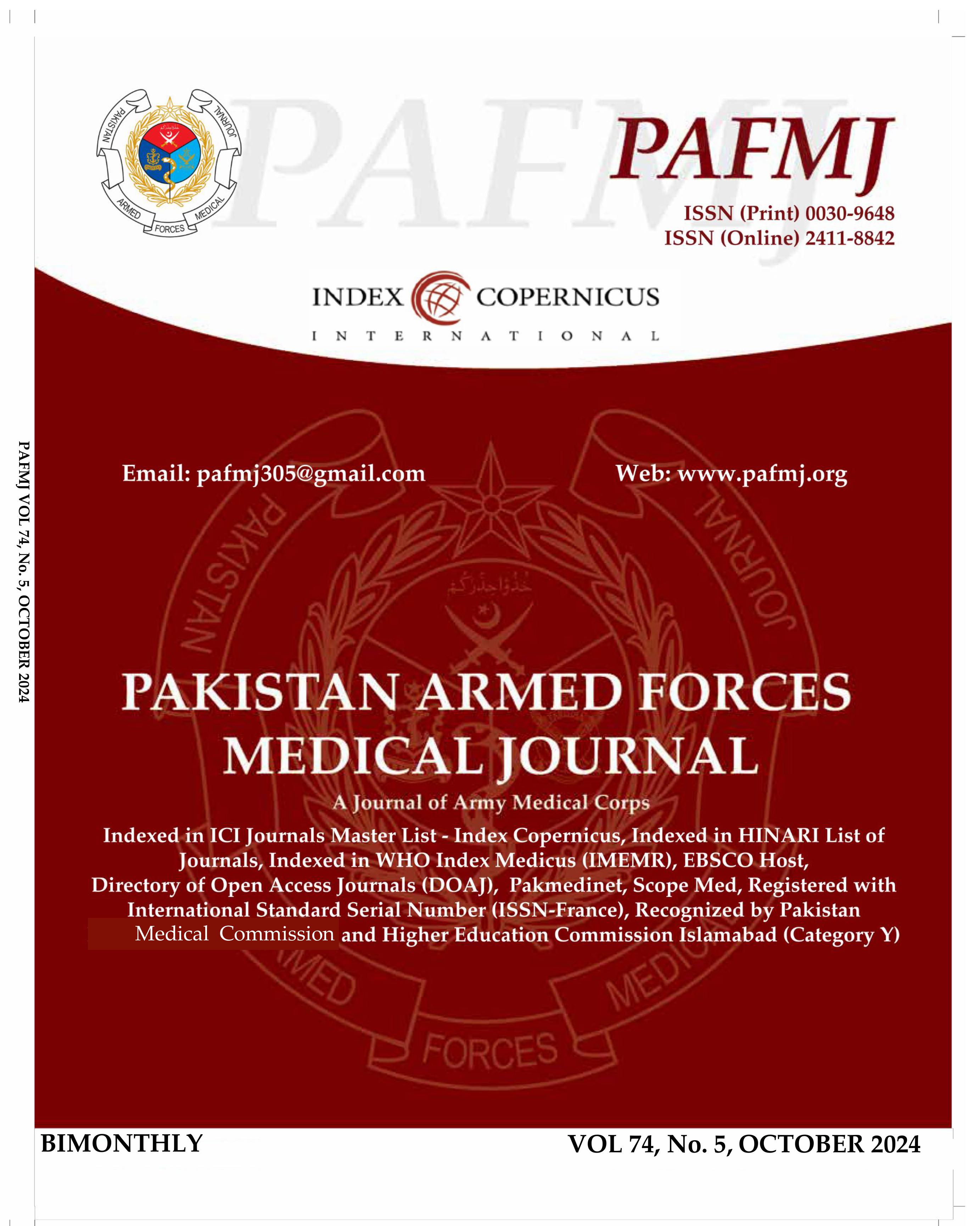Outcomes of Type-1 Tympanoplasty with and without use of Topical Nasal Steroids; a Comparative Study
DOI:
https://doi.org/10.51253/pafmj.v74i5.11037Keywords:
Chronic suppurative otitis media, Deafness, Steroids, TympanoplastyAbstract
Objective: To compare the outcome of Type-1 tympanoplasty procedure in patients given intranasal steroids post-operatively versus those not given intranasal steroids after procedure.
Study Design: Quasi-Experimental study.
Place and Duration of Study: Combined Military Hospital, Rawalpindi. Pakistan from May 2021 to May 2023.
Methodology: A total of 464 patients, 232 of which were given intranasal steroids (Group-A), and 232 who were not given intranasal steroids (Group-B) were made part of this research. Upon inclusion, all pre-operative demographics were documented. Patients in post-operative follow up period were assessed for condition of tympanic membrane and improvement of hearing ability.
Results: In current study, post-operatively, in patients who were given intranasal steroids, graft take-up frequency was 227(97.84%) and residual perforation was 5(2.16%) was better than in patients who were not given intranasal steroids, which came to 224(96.55%) and 8(3.45%), respectively (p=0.399). In terms of post-operative WHO grade of hearing impairment distribution (p<0.001) and post-op hearing status (p=0.005) difference between patients who were given intranasal steroids and those not given intranasal steroids was statistically significant.
Conclusion: Addition of intranasal steroid spray to the treatment regimen following tympanoplasty is provides better outcomes in terms of higher graft take-up frequency and an improvement in hearing from preoperative levels.
Downloads
References
Khairkar M, Deshmukh P, Maity H, Deotale V. Chronic suppurative otitis media: a comprehensive review of epidemiology, pathogenesis, microbiology, and complications. Cureus 2023; 15(8): e43729.
https://doi.org/10.7759/cureus.43729
Uddén F, Filipe M, Reimer Å, Paul M, Matuschek E, Thegerström J, et al. Aerobic bacteria associated with chronic suppurative otitis media in Angola. Infect Dis Poverty 2018; 7(1): 42.
https://doi.org/10.1186/s40249-018-0422-7
Verhoeff M, van der Veen EL, Rovers MM, Sanders EA, Schilder AG. Chronic suppurative otitis media: a review. Int J Pediatr Otorhinolaryngol 2006; 70(1): 1-12.
https://doi.org/10.1016/j.ijporl.2005.08.021
Singer AEA, Abdel-Naby OG, El-Kader RMA, Mohamed AR. Risk factors of sensorineural hearing loss in patients with unilateral safe chronic suppurative otitis media. Am J Otolaryngol 2018; 39(2): 88-93.
https://doi.org/10.1016/j.amjoto.2018.01.002
Chavan RP, Ingole SM, Birajdar SN. Overview of tympanoplasty techniques and results. Int J Otorhinolaryngol Head Neck Surg 2017; 3(2): 170-175.
https://doi.org/10.18203/issn.2454-5929.ijohns20170360
Patil BC, Misale PR, Mane RS, Mohite AA. Outcome of interlay grafting in type 1 tympanoplasty for large central perforation. Indian J Otolaryngol Head Neck Surg 2014; 66(4): 418-424.
https://doi.org/10.1007/s12070-014-0741-3
Kim HC, Park KS, Yang HC, Jang CH. Surgical results and factors affecting outcome in patients with fat-graft myringoplasty. Ear Nose Throat J 2021: 1455613211063243.
https://doi.org/10.1177/01455613211063243
Bowyer A, Royse C. The importance of postoperative quality of recovery: influences, assessment, and clinical and prognostic implications. Can J Anaesth 2016; 63(2): 176-183.
https://doi.org/10.1007/s12630-015-0508-7
Shah RK, Shrestha K, Sapkota S, Giri S. Outcome of type 1 tympanoplasty with and without the use of topical nasal steroid: A comparative study from Eastern Nepal. Birat J Health Sci 2018; 3(1)5: 377-380. https://doi.org/10.3126/bjhs.v3i1.19765
Charan J, Biswas T. How to calculate sample size for different study designs in medical research? Indian J Psychol Med 2013; 35(2): 121-126. https://doi.org/10.4103/0253-7176.116232
Morris P. Chronic suppurative otitis media. BMJ Clin Evid 2012; 2012: 0507.
Neogi R, Dan A, Maity K, Basak B, Basu D, Acharya M, et al. Clinico-epidemiological profile of chronic suppurative otitis media patients attending a tertiary care hospital. J Indian Med Assoc 2011; 109(5): 324-326.
Olusanya BO, Davis AC, Hoffman HJ. Hearing loss grades and the International classification of functioning, disability and health. Bull World Health Organ 2019; 97(10): 725-728.
https://doi.org/10.2471/BLT.19.230367
Khawaja M, Sajid T, Aziz T, Ashfaq U, Khan A. Comparison of graft uptake by underlay and overlay technique in myringoplasty. J Ayub Med Coll Abbottabad 2020; 32(Suppl 1)(4): S640-S643.
Lee JC, Lee SR, Nam JK, Lee TH, Kwon JK. Comparison of different grafting techniques in type I tympanoplasty in cases of significant middle ear granulation. Otol Neurotol 2012; 33(4): 586-590.
https://doi.org/10.1097/MAO.0b013e31824b78ba
Mahdiani S, Lasminingrum L, Anugrah D. Management evaluation of patients with chronic suppurative otitis media: A retrospective study. Ann Med Surg 2021; 67: 102492.
https://doi.org/10.1016/j.amsu.2021.102492
Abraham ZS, Ntunaguzi D, Kahinga AA, Mapondella KB, Massawe ER, Nkuwi EJ, et al. Prevalence and etiological agents for chronic suppurative otitis media in a tertiary hospital in Tanzania. BMC Res Notes 2019; 12(1): 429.
https://doi.org/10.1186/s13104-019-4483-x
Acuin J. Chronic suppurative otitis media. BMJ Clin Evid 2007; 2007: 0507.
Tahir H, Ali I, Malik SA. Hearing assessment and status of tympanic membrane pre and post-operated tympanoplasty in cases of CSOM. Professional Med. J 2020; 27(12): 2581-2585.
https://doi.org/10.29309/TPMJ/2020.27.12.4624
El-Anwar MW, Nofal AA, Khazbak AO, Sayed AE, Hassan MR. The efficacy of nasal steroids in treatment of otitis media with effusion: a comparative study. Int Arch Otorhinolaryngol 2015; 19(4): 298-301.
https://doi.org/10.1055/s-0035-1548535
Butler CC, Van Der Voort JH. Oral or topical nasal steroids for hearing loss associated with otitis media with effusion in children. Cochrane Database Syst Rev 2002; (4): CD001935.
Downloads
Published
Issue
Section
License
Copyright (c) 2024 Ayesha Khan, Naeem Riaz, Faisal Manzoor, Kamran Zamurrad Malik, Sunarays Akhtar, Shahzad Hanif

This work is licensed under a Creative Commons Attribution-NonCommercial 4.0 International License.















